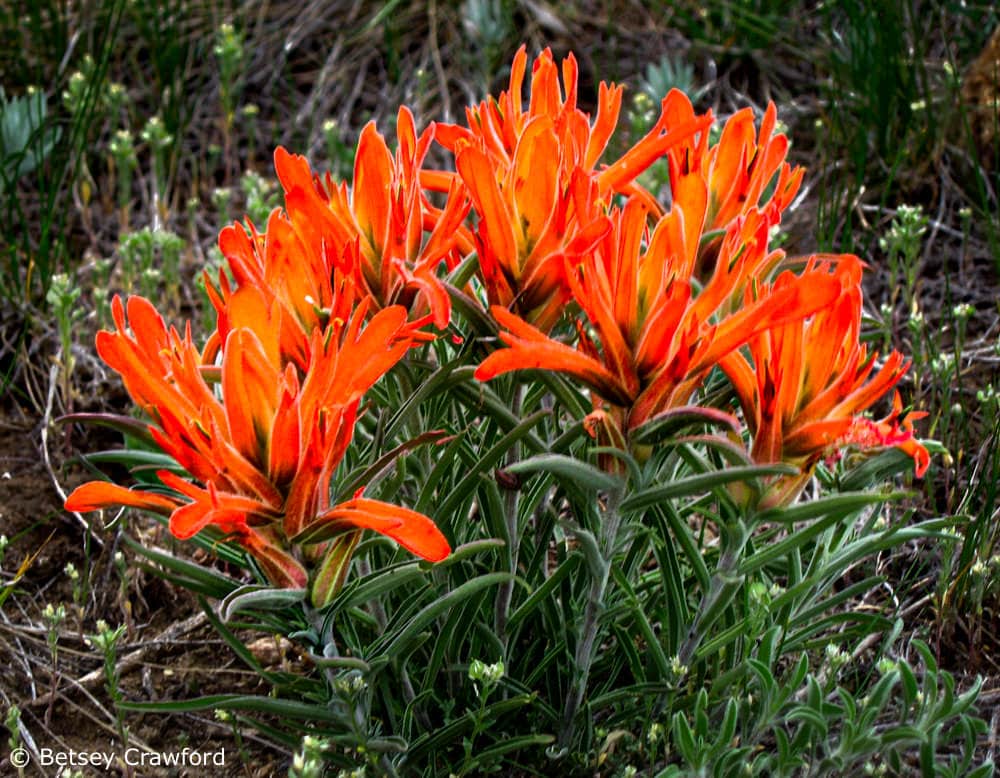
I first saw a paintbrush, a member of the Castilleja genus, in Idaho. Then again in southern California, and then northern. Then Colorado and Utah, British Columbia and Alberta, and then Alaska. I haven’t yet seen them in Wyoming, but it’s the state flower, so I know they’re there.
If you’re west of the Mississippi, it’s easy to find Castilleja. They grow in almost all conditions, except swamps or deep woods, and some can withstand toxic serpentine soils. One species in the 250-strong family grows in the east, but I’d never seen one before coming west.

In most places they’re hard to miss: many are as vivid a red or orange as you can find. They usually stand one to two feet tall, and they grow in patches. The vivid color is not the flower, but modified leaves called bracts. These surround and protect the inconspicuous flowers, whose petals wrap around each other, forming a tube. Though the flowers are bright green, they can’t hold a candle to the surrounding brilliance. The colorful bracts do the job that petals normally do: lure pollinators, especially butterflies and hummingbirds.
Paintbrushes are also white, pink, yellow and purple. As common as they are, it’s impossible to take them for granted. Because they change with the light, you never know what you’re going to find. On a cloudy day, high on a mountain in British Columbia, were alpine versions — one red, one magenta — that glowed in the muted gray light. The luminous yellow Alaskan native does the same thing in the long summer twilights.

I found a red one on fire against the bright rock of a Utah trail. A chrome yellow one in front of a blackened log in a burned forest. A white one shone in the shade at the edge of the woods in Waterton Lakes, and a red one, along a woodland path, glittered in a shaft of sunlight.
They are everywhere, irresistibly gorgeous, and fascinating, because they’re parasites. They have green leaves on the stem below the bracts, and then a cluster of leaves at the base. That means they can photosynthesize, but usually find a host to help, often a grass or sagebrush, as well as other flowers and shrubs. They send out haustoria, specialized roots that penetrate the host’s roots, slithering between cells. There, they find water and nutrients to supplement their own photosynthesizing.

They’re not alone in this. Castillejas have recently been put into the Orobanchaceae, a whole family of parasites. Some are completely parasitic; some, like the Castillejas, partially, or hemiparasitic. At first glance, it’s hard to see why evolution thought this was a good idea. It certainly benefits the parasite, and some do no discernible harm, but most affect their hosts. About 10% of the 270 parasitic genera are invasive pests, causing serious problems for farmers and capable of killing hosts in natural settings.
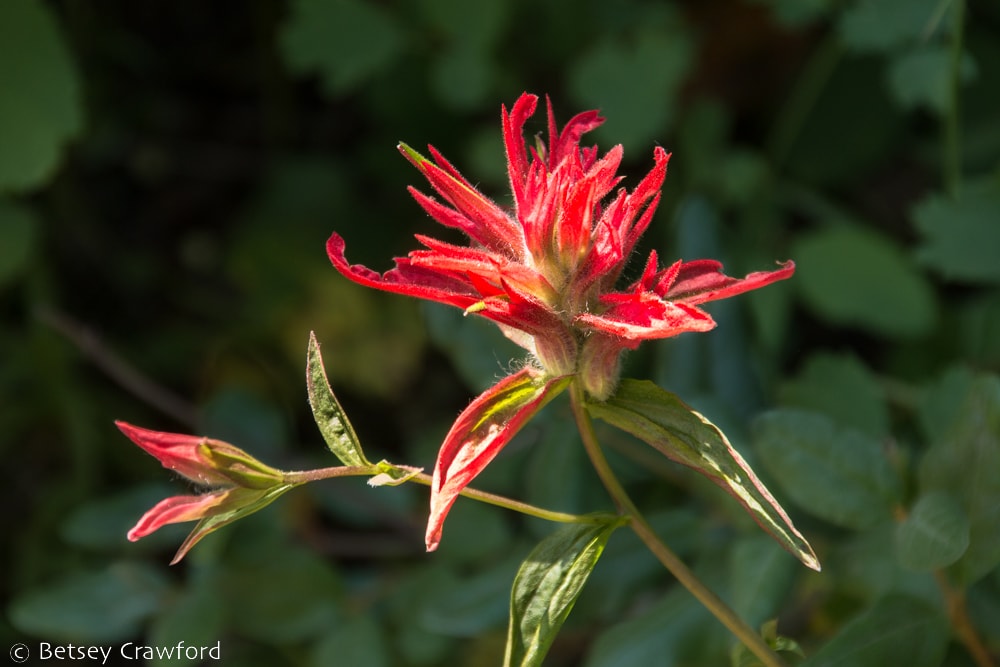
Castillejas don’t kill their hosts, though studies show that the hosts are less robust than they otherwise would be. That sounds like a negative. But by preventing one or two species from dominating, one effect may be to allow more diversity in an area . Castillejas are usually biennials, growing from seed one year, blooming the next, and dropping their seed to germinate the following spring.
Taking advantage of the mature, deep roots of the perennial plants around them means a ready source of nourishment and water. This means more vigorous growth in their brief life. That fast cycle has another possible benefit: they quickly return nutrients to the soil through their decaying leaves.

So, while they are not symbiotic, with obvious mutual benefit to both plants, they aren’t vampires, despite my inability to resist the title. Parasite is from the Greek for ‘next to’ (para) and food (sitos), thus giving us ‘next to the food.’ Which, while accurate, is pretty dull. And this underground search for food is anything but dull.
It brings us back to the fascinating question of what plants know and how they know it. Although roots can bump into each other, evolution wouldn’t favor their chance meeting. Are the Castillejas sensing chemical signals given off by the roots of the host plant? The stems of dodder, the most famous of the invasive parasites, can ‘smell’ its highly desired tomato plant and send its tendrils that way. But those chemicals are airborne. Can plant scents travel underground?

Apparently. Plants use their aromatic phenolic compounds, the same family of chemicals that gives us, for example, flavonoids and other antioxidants, to talk to each other. With root parasites, the host’s phenolic molecules move through the soil. Enzymes in the parasite convert them into haustorium-inducing factors.
The haustoria get underway, following the chemicals back to the host’s root system. There they penetrate the cell walls without destroying the cell membrane. Once there, they pipe nutrients, carbon, and water back to the parasitic plant. The higher transpiration rates of some parasites facilitate this exchange. Evaporation is faster from Castilleja leaves, which pulls water away from the more slowly transpiring host’s roots.
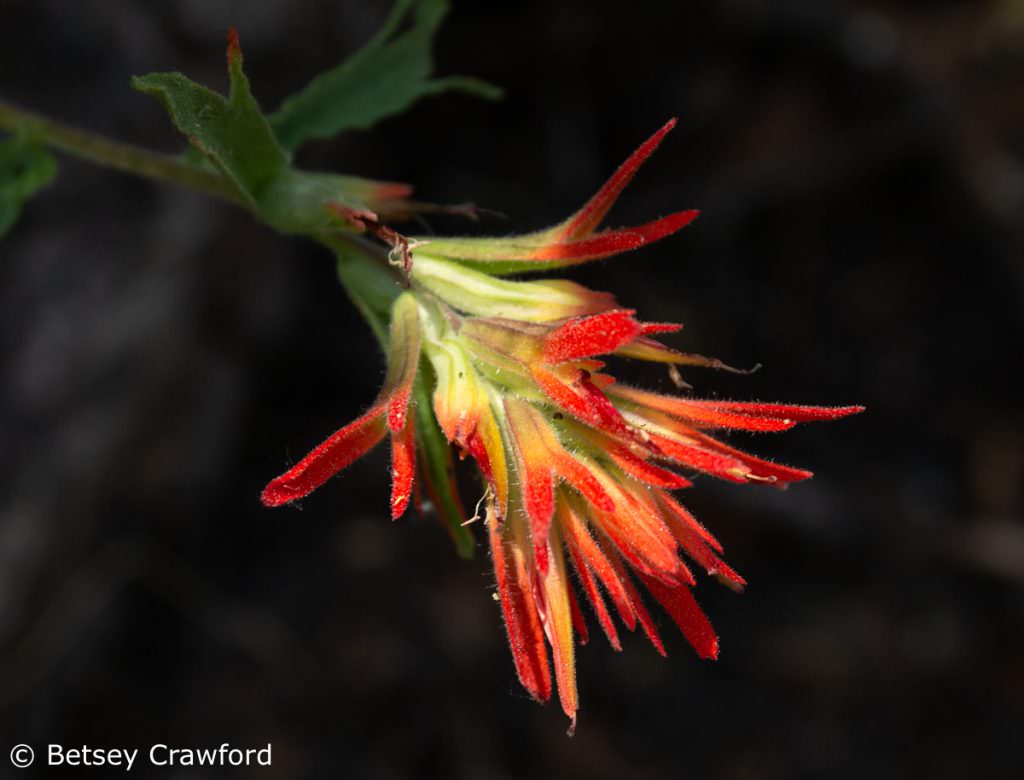
While we stand enchanted by their vivid and luminous beauty, Castillejas are busy. They have a lot to do in the two years they live and have to pack all the nutrition they can into their seeds. All to continue to lure hummingbirds, get pollinated, and keep the family line going.
Of course, they are not ‘thinking’ about all of this, but there is intelligence at work, and I find that profoundly moving. Though our evolutionary ways parted company two billion years ago, we share common ancestors. We still share a quarter of our genes with plants. What became our prefrontal cortex has its origins in the same rudimentary processing cells that our ancient relatives once shared.
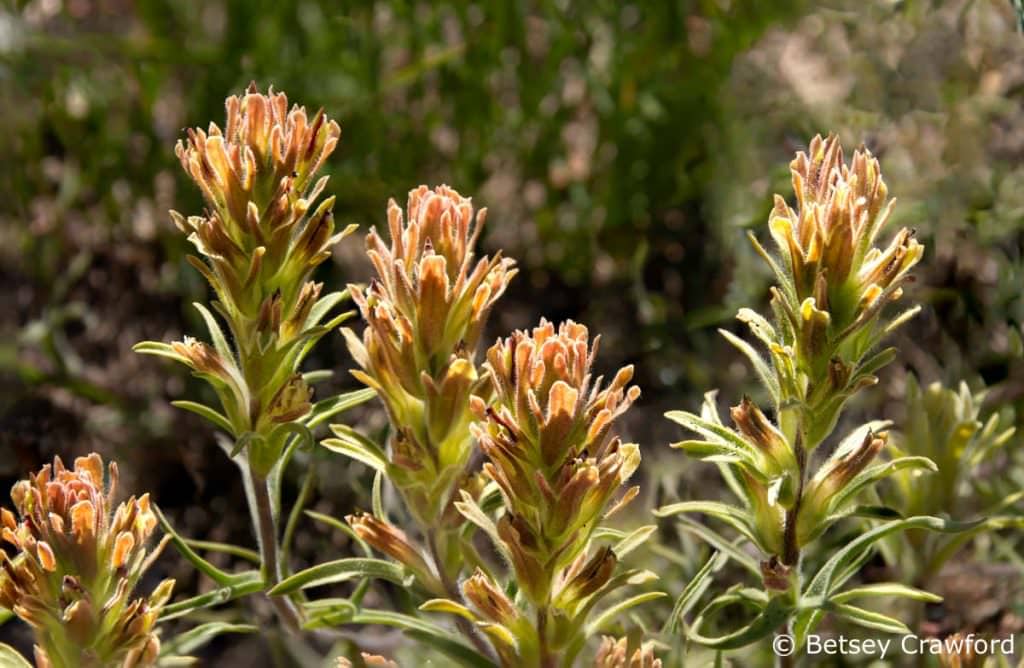
To prosper, all living things have to be able to respond and adapt to the world around them. Some people have a hard time calling this intelligence, reserving that trait for the human mind. Perhaps for animals that show signs of operating from more than instinct.
In his fascinating book, What a Plant Knows, botanist Daniel Chamovitz suggests instead that we think in terms of plants being aware of the world they inhabit. But I have no trouble with the word intelligence. I like his idea that “‘human’ may be only a flavor, albeit an interesting one, of intelligence.” This concept helps open the boundaries we’ve used to set us apart from the rest of creation, a crucial step in the care and preservation of the natural world.

Top photo: Whole-leaf paintbrush (Castilleja integra), Colorado
There are more pictures in the Castilleja gallery.
I’d love to have you on the journey! If you add your email address, I’ll send you notices of new adventures.
Related posts:
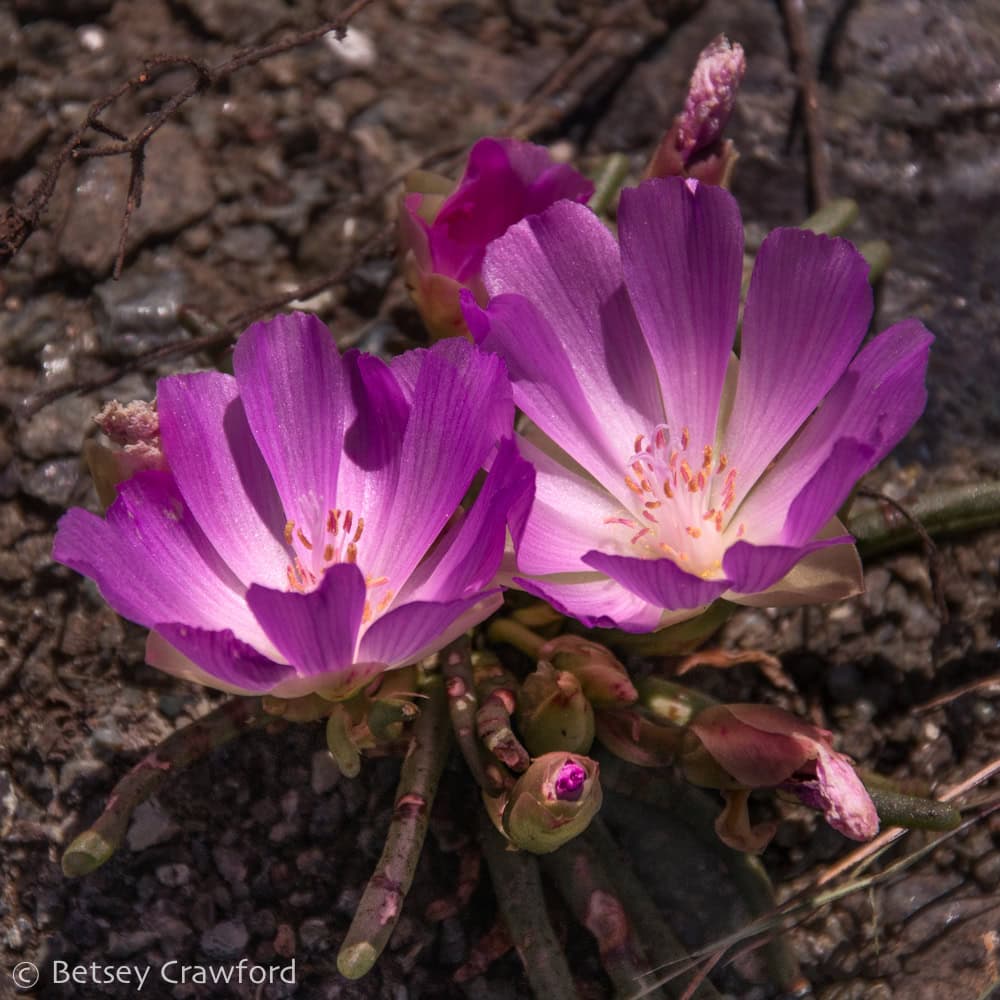
LIVING ON THE LEDGE: INGENIOUS BITTERROOT
This is a story about a difficult and fascinating terrain, a beautiful, adaptable flower, and a maddening claim. There are thousands of such stories in the intertwined history of humans and plants.
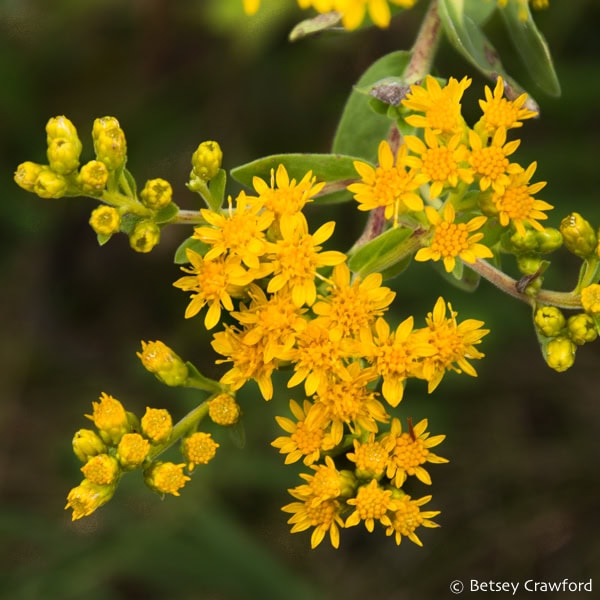
THE GOLD RUSH: THE JOYFUL POWER OF GOLDENROD
A late summer trip east brought me something I miss in California: a world awash in goldenrod. There are so many things to love about this wonderful wildflower. This is nature at her most exuberant. Standing in a field of goldenrod connects us directly to the beating of her vibrant heart.
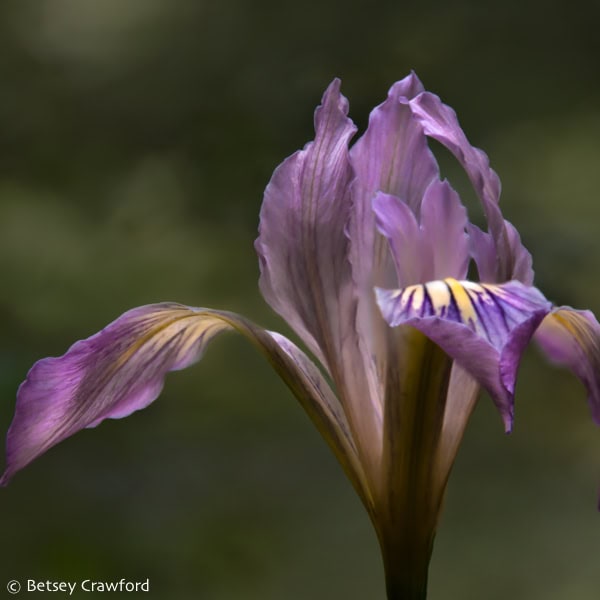
ELEGANT, WILD, MYSTERIOUS: LOVING IRIS
Iris are full of beauty and evolutionary intelligence. Flowers are not their reproductive habits, their petals, their relationships, as fascinating as all those are. They are voices of the great forces that are continually bringing, the cosmos into being. Our love for them may help save the planet.
Stupendous page on Castillejas, thank you. Howsomeever I don’t think most Castillejas are biennials.
Thank you! I’ll have to check that out. I love it when people chime in like this.
Betsy,
Fascinating! Beautiful photos as always- I enjoy being a part of your journey.
Kathy
Thank you for bringing the beauty of the world into the beauty of your writing….and into our living rooms and hearts….
What a lovely comment! Thank you, Annie.
Betsy, it is always a pleasure to see your beautiful wildflowers and your exquisite photography.
Thanks so much, Alicia. Lovely to know you’re part of this.